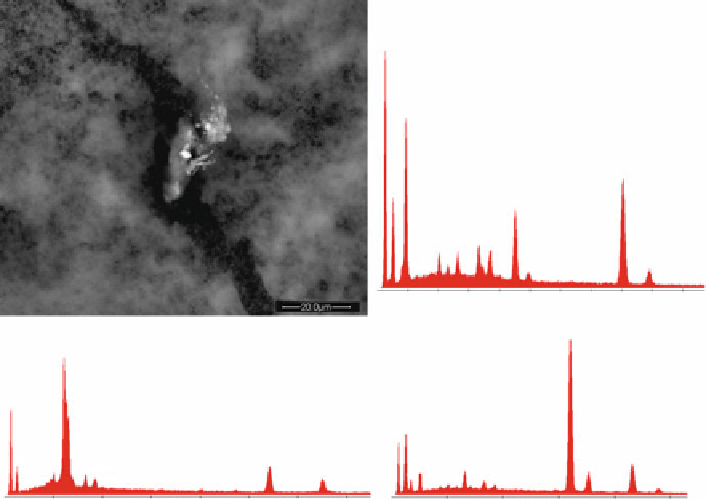Environmental Engineering Reference
In-Depth Information
a
b
C
Cu
Cu
O
Ti
K
P
S
CI
Ca
1.00 2.00 3.00 4.00 5.00 6.00 7.00 8.00 9.00 10.00
c
Fe
d
Bi
C
O
C
O
Bi
CI Ca
Zn
K
P
Fe
Zn
Ca
K
2.00
4.00
6.00
8.00
10.00
12.00
14.00
2.00
4.00
6.00
8.00
10.00
Fig. 10.5 SEM image of an Italian yogurt where submicronic and nanosized inorganic particles
were detected. Particles of (b) Copper, Titanium, Phosphorus, Sulfur, Chlorine, Potassium,
Calcium; (c) Bismuth, Phosphorus, Potassium, Calcium; (d) Iron, Zinc, Chlorine, Calcium
sausage also known in English as Bologna) that is a mix of fatty cubes embedded in
homogenized pork meat.
There are a few differences in the preparation of fatty and oily samples
according to their being solid or fluid. Usually, the fluid specimen is spread on a
cellulose filter, dehydrated in an oven for 1 h and observed under the microscope. In
the case of chocolate and yogurt (Fig.
10.5
), they are heated, in some cases diluted,
and finally deposited on a filter. In some cases, for instance milk or fruit juice, it is
necessary to make a preventive centrifugation before the deposition on the support
for the ESEM investigation.
In the case we mentioned above of mortadella, the presence of particulate matter
was immediately suspected at the preliminary inspection of the specimens because
of the presence of grayish spots barely visible to the naked eye in the pink areas of
the meat and better visible through an optical microscope. In that case, under a
stereomicroscope, we cut only those blots and smeared the matter on the Carbon
disc of the stub in order to get a thin film. Embedded in that matrix we spotted
irregularly shaped stainless steel debris whose corrosion had caused the discolor-
ation of the meat. The origin of those debris was the wear of the blades used to
mince the frozen pork meat (Fig.
10.8
).
The identification of inorganic particulate matter, not biodegradable, so
biopersistent and not biocompatible, is quite a novelty in the field of food [
2
-
8
]

